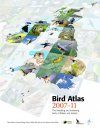"This highly authoritative county avifauna is the result of five years of hard work from a dedicated team of editors and contributors under the auspices of the Durham Bird Club. Its publication has been made possible by the ‘Birds of Durham Heritage Project’, which attracted £30,000 in funding from the national lottery. It is a worthy successor to A History of the Birds of Durham, written by George Temperley and published in 1951. At that time, the Durham list comprised 273 species but by the end of 2011 it had reached 393. This increase is due largely to a mouth-watering list of rarities but the county also has a strong suite of breeding species, including several iconic upland birds such as black grouse Tetrao tetrix, merlin Falco columbarius and European golden plover Pluvialis apricaria. The area covered is the present-day administrative county plus additional areas in south Tyne & Wear and north Cleveland, which are included in the vice-county of Durham. It thus includes Whitburn and Hartlepool Headland, key sites for seawatching and attracting migrants, and the Tees marshes, which form the largest wetland between the Humber and Lindisfarne and attract significant numbers of waterfowl as well as a variety of rare waders.
There are five introductory chapters. The first, ‘Durham geography – landscape, habitats, climate and bird life’, gives an excellent overview of the county, although the superb habitat photographs are found elsewhere in the book. The second, ‘A short environmental history of Co. Durham’, focuses on land use and includes coal mining, game rearing, changing farming practices and the spread of industry. ‘The study of birds in Co. Durham’ covers the first known references to birds in the county and major figures in the development of ornithology through the nineteenth and twentieth centuries, and describes the formation of the Durham Bird Club in 1974 and its development through to the present day. ‘A short history of Durham Ornithology’ is a chronology of major ornithological events and bird records, while ‘Birds of Durham – the Durham list’ looks at the development of the county list through time, makes comparisons with adjacent counties and looks to the future.
Most of the book (865 pages) is taken up by the systematic list. Each species account begins with a concise statement of current status and a small vignette. The accounts for regular species have three or four subheadings – historical review, recent breeding status, recent non-breeding status (the last two combined as recent status for non-breeders), and distribution and movements – and this standardised approach works very well for most species. The historical reviews include discussion of the earliest records, a summary of the information published by Temperley and a review of subsequent sightings up to the 1970s.
The sections on status are extremely detailed, giving lengthy summaries of changes in breeding distribution and numbers, maximum counts at various locations or a chronology of noteworthy records of migrants. Sadly, the opportunity to use bar charts and tables to summarise count data and analyse the occurrence of scarcer species more effectively has been taken only infrequently – and inconsistently. Thus some species are analysed by month and others by ten-day period; for example, bluethroat Luscinia svecica gets both a monthly and a five-day analysis yet there are no charts for Temminck’s stint Calidris temminckii or wood sandpiper Tringa glareola. Maximum counts of several waders have been displayed over a 40-year period, some by means of bar charts and others by line graphs (the latter inappropriate for discontinuous data of this sort), yet there is no display of counts of wildfowl. Seawatching data from Whitburn and Hartlepool are analysed in various ways: divers, tubenoses and some auks have charts to illustrate patterns of occurrence, but for skuas there are only lengthy texts.
A final section gives a brief overview of the wider distribution of each species and summarises the ringing data pertinent to the county.
For those rarities with fewer than 20 records, all are listed in full. Each account begins with a description of the discovery of the first for the county. Many photographs of county firsts and other rarities have been included, with older black-and-white shots in the text and high-quality colour photographs in two bound sections. Information is included for the period up to the end of 2011.
Appendices cover Category D and E species; unconfirmed and unacceptable records; contributing authors, photographers and sponsors; a map of the county with a gazetteer of sites; and a 37-page bibliography.
This is a fine avifauna [...]. However, I do feel that more stringent editing of the species texts, combined with greater use of graphs and tables and the use of colour throughout, would have enlivened the monotonous appearance of many pages. [...]"
- John Clark, britishbirds.co.uk, 16-02-2013


































